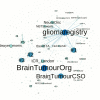Social media partnerships with patient organizations for neuro-oncology patient recruitment
- PMID: 32626583
- PMCID: PMC7318861
- DOI: 10.1093/nop/npz049
Social media partnerships with patient organizations for neuro-oncology patient recruitment
Abstract
Background: In neuro-oncology, traditional methods of enrolling the large numbers of participants required for studies of disease etiology and treatment response are costly, labor intensive, and may not include patients in regions without tumor registries.
Methods: In the Yale Acoustic Neuroma (AN) Study and International Low-Grade Glioma (LGG) Registry, we partnered with several brain tumor patient organizations to develop social media enrollment campaigns and use web-based data collection resources at the Yale University School of Public Health to test alternative methods to enroll neuro-oncology patients for epidemiologic study.
Results: In the AN study, we enrolled 1024 patients over 2 years. Of these, 865 patients completed the online questionnaire, 697 returned written consent, 583 sent a pathology report, and 569 returned a saliva specimen. The completed 569 participants did not differ by age or treatment from the National Cancer Institute's Surveillance, Epidemiology, and End Results (SEER) data but were more likely to be female (67% vs 52%) and white (94.8% vs 84%). Patients learned of the study through the Acoustic Neuroma Association (ANA) website (61.3%), ANA support group members (18%), and social media (primarily Facebook). Costs per patient enrolled were approximately 10% to 20% that of traditional registry-based enrollment methods. Results for the LGG study were similar.
Conclusions: Although additional effort will be required to ensure a diverse participant population, partnership with established patient organizations along with use of web-based technology and social media allowed for the successful enrollment of neuro-oncology patients at a fraction of the cost relative to traditional methods.
Keywords: registry; social media; acoustic neuroma; low-grade glioma; patient organization.
© The Author(s) 2019. Published by Oxford University Press on behalf of the Society for Neuro-Oncology and the European Association of Neuro-Oncology. All rights reserved. For permissions, please e-mail: journals.permissions@oup.com.
Figures

References
-
- National Institutes of Health, Research Portfolio Online Reporting Tools. Rare Diseases Clinical Research Network. 2018. https://report.nih.gov/nihfactsheets/ViewFactSheet.aspx?csid=126. Accessed July 24, 2019.
-
- Pew Research Center. Internet/Broadband Fact Sheet. 2018. https://www.pewinternet.org/fact-sheet/internet-broadband/. Accessed July 24, 2019.
-
- Pew Research Center. Share of U.S. Adults Using Social Media, Including Facebook, is Mostly Unchanged Since 2018. 2019. https://www.pewresearch.org/fact-tank/2019/04/10/share-of-u-s-adults-usi.... Accessed July 24, 2019.

